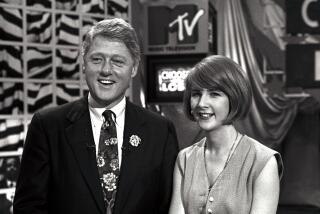Times Publishes ‘B.C.’ Cartoon After Protests
- Share via
The Los Angeles Times, which chose not to print a “B.C.” cartoon strip last Sunday with a Christian theme, is publishing that day’s strip in today’s religion section.
The decision to run the Palm Sunday cartoon followed protests from readers who were alerted by religious broadcaster Pat Robertson on his “The 700 Club” television program last Tuesday. Objections were also raised by the Christian Coalition, a national political action organization founded by Robertson, a onetime candidate for the Republican presidential nomination.
Narda Zacchino, The Times’ associate editor, said the paper decided to run the “B.C.” cartoon because the issue had become a news story. She said it was placed in today’s religion section instead of on the comics pages because “that is a more appropriate place for it.”
Some readers complained that while The Times had decided not to run the “B.C.” cartoon, which they described as a positive reflection on Christianity, the paper had run an editorial cartoon on its opposite-editorial page, which they charged was offensive to some Christians. That editorial cartoon by Paul Conrad depicted Republican presidential hopeful Bob Dole being crucified on a cross with a crown of thorns labeled “Christian Coalition” on his head.
“Paul Conrad’s drawing is the sort of provocative work that has distinguished him in public affairs controversies over the years. Political cartoons, like politics, are not bean bags,” said Times Editor Shelby Coffey III.
In addition, two “B.C.” strips that normally would not have been published regardless of content because they routinely alternate with another cartoon feature, are also being printed in the religion section today. A Good Friday cartoon that also was not in the normal rotation was nonetheless published yesterday on the comics pages.
In the Palm Sunday strip in question, “B.C.” cartoonist Johnny Hart--who describes himself as a professing Christian--draws on a theme of the Crucifixion. In the strip, Wiley, a caveman character, speaks of the Christian belief in Jesus’ atoning through his death on the cross for the sins of the world.
Zacchino said this is not the first time the paper has made an editorial decision not to run a cartoon strip.
“Times editors edit the comics pages as we do the content of the rest of the newspaper,” she said. “On occasion, we have omitted comics from our comics pages, making judgments on a case-by-case basis, from ‘Mister Boffo’ and ‘Outland’ to ‘Non Sequitur,’ ‘Doonesbury’ and ‘Mother Goose and Grimm.’ In the past, we have run ‘B.C.’ cartoons with a religious theme, and we have pulled ‘B.C.’ cartoons which contained a definite religious message that we viewed as inappropriate for the comics pages.
“We are mindful that The Times is a secular publication serving a large and quite diverse and pluralistic community. While we respect affirmations of personal religious faith, we also are aware that aggressively urging such affirmations on others who have not sought them out may be considered proselytizing and inappropriate for the comics pages,” she said.
Ralph Reed, executive director of the Christian Coalition, accused The Times of censorship and insensitivity. “The combination of Conrad’s depiction of Dole as a crucified Christ figure and politically active people of faith as his murderers combined with the censorship of [the ‘B.C.’ cartoon] to us shows a disturbing pattern of censorship of positive religious themes and insensitivity toward people of faith,” Reed said.
Reed said that he was “obviously pleased” that The Times was publishing the “B.C.” cartoons in question, but he said he was concerned about their placement on the religion pages. “It suggests a ghettoization of religious themes,” Reed said.
Zacchino denied that the paper was engaged in censorship. “This is not censorship. This is editing,” she said. “The Conrad cartoon appeared on the op-ed page, where one expects to find political satire or thought-provoking articles and cartoons. There is a major distinction between the comics pages and the editorial and op-ed pages and what the reader expects to see there.”
As a matter of course, she said, “We don’t intend to run our comic strips on the religion page, nor would we have run these on the religion page if it had not become a news story.”
More to Read
The biggest entertainment stories
Get our big stories about Hollywood, film, television, music, arts, culture and more right in your inbox as soon as they publish.
You may occasionally receive promotional content from the Los Angeles Times.









